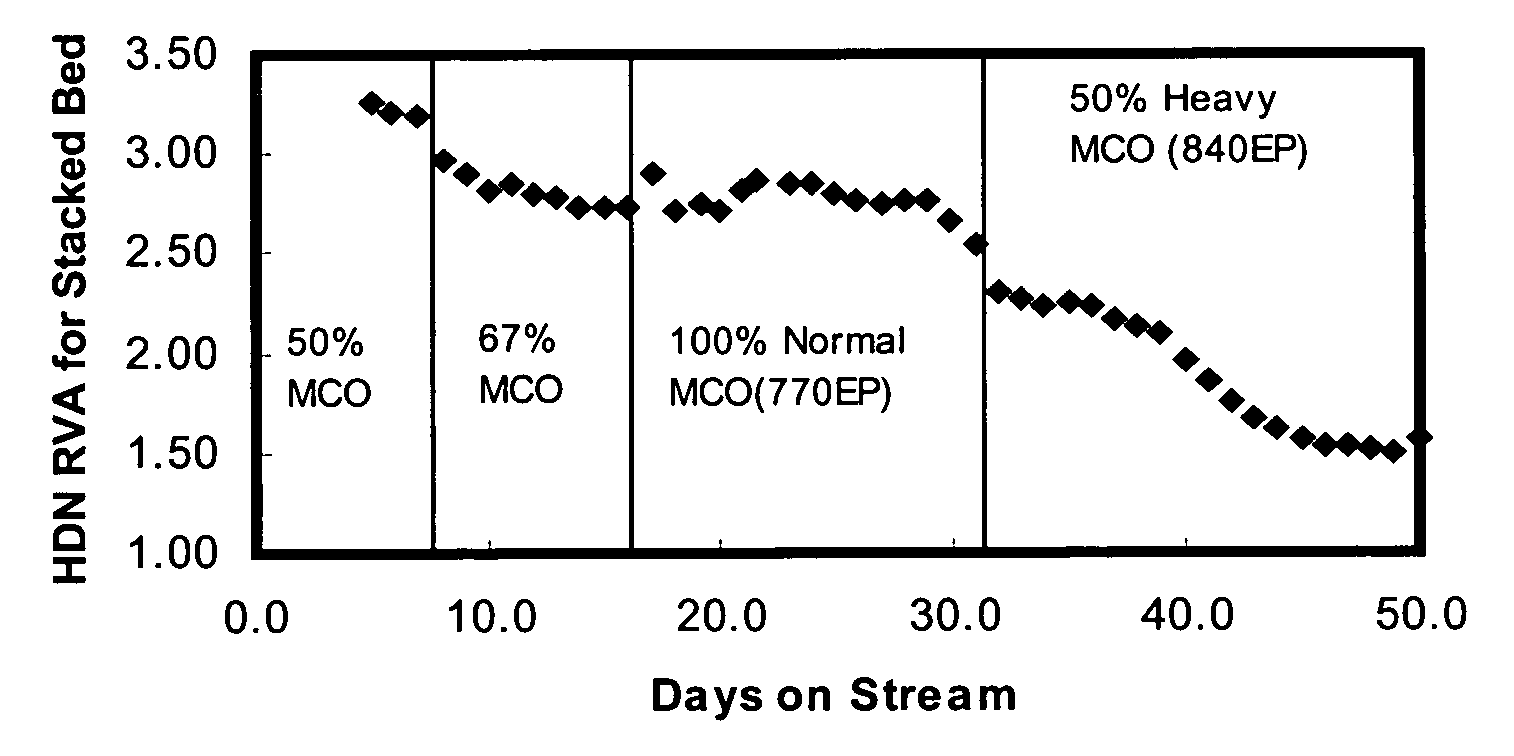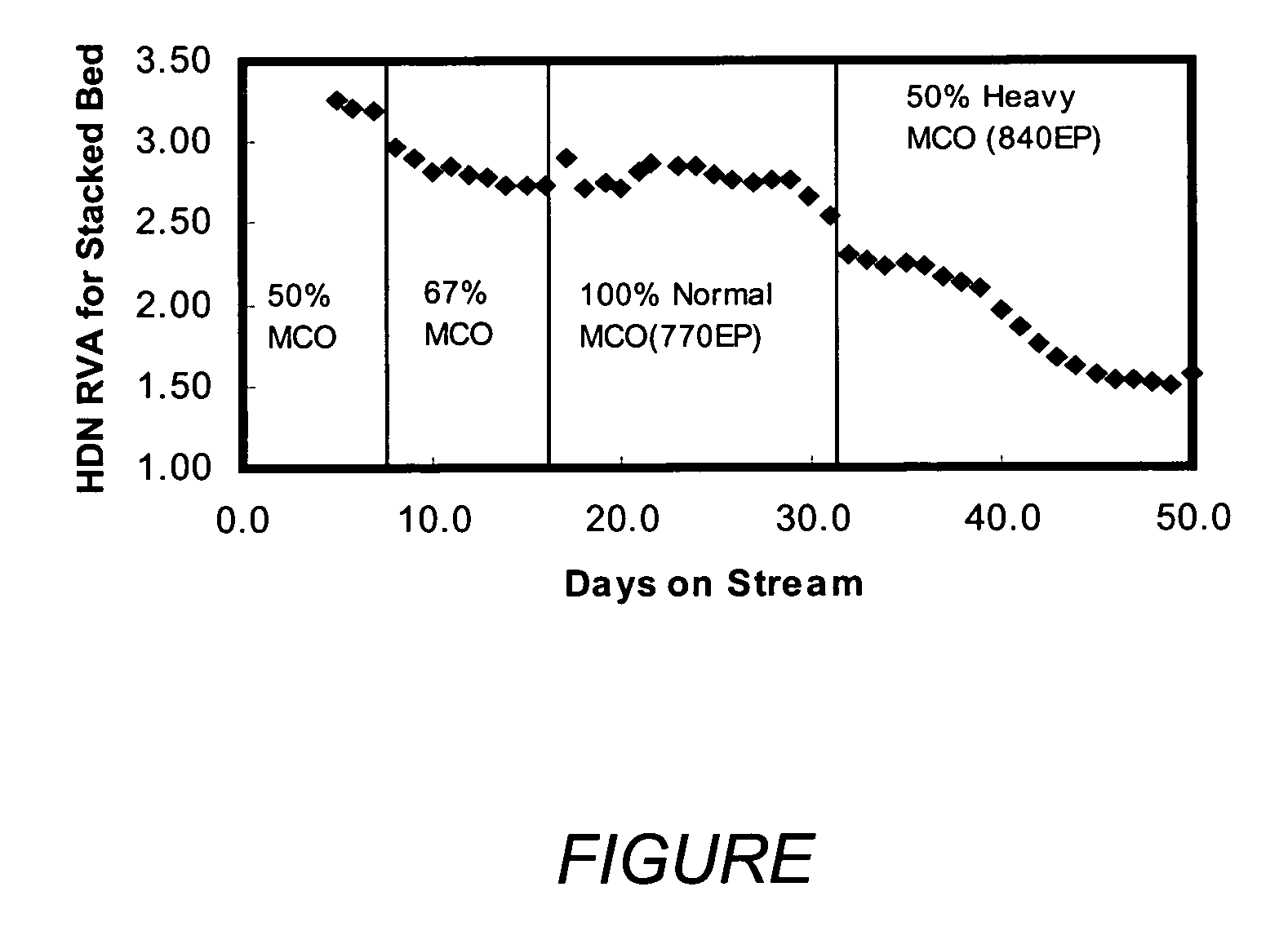Process for making lube oil basestocks
a technology of lubricating oil basestocks and base oils, which is applied in the direction of hydrocarbon oil treatment products, physical/chemical process catalysts, metal/metal-oxide/metal-hydroxide catalysts, etc., can solve the problems of increasing the proportion of naphthenic and asphaltic base crudes, increasing the difficulty of meeting the demand for lubricating oil basestocks or base oils, and involving expensive operating conditions and low yields
- Summary
- Abstract
- Description
- Claims
- Application Information
AI Technical Summary
Benefits of technology
Problems solved by technology
Method used
Image
Examples
example 1
[0058]A medium vacuum gas oil having the properties outlined in Table 1 was processed in an isothermal pilot plant over three catalysts systems at 1200 psig hydrogen partial pressure. The catalyst systems and operating conditions are given in Table 2. Catalyst B is a conventional hydrotreating catalyst having about 4.5 wt. % Group VI metal, about 23 wt. % Group VIII metal on an alumina support and has an average pore size of 14.0 nm. The bulk metal hydrotreating catalyst was a commercial bulk metal hydrotreating catalyst marketed under the name Nebula by Akzo-Nobel.
[0059]In the Examples, all the catalyst systems were lined out at about 50 days on stream. A first order kinetic model with an activation energy of 31,000 cal / gmol was used to compare volume activities between the catalysts.
[0060]
TABLE 1Medium Vacuum Gas OilDensity at 70° C. (g / cc)0.88Nitrogen (wppm)700Sulfur (wt. %)2.6GCD 5 WT % Boiling Point (° C.)334GCD 50 WT % Boiling Point (° C.)441GCD 95 WT % Boiling Point (° C.)531...
example 2
[0063]The hydrotreating ability of different stacked beds of Catalyst B and Nebula were analyzed by hydrotreating different feedstreams over the stacked beds in the in two parallel reactor trains of the same isothermal pilot plant unit used in Example 1 above. The feedstreams used were Medium Cycle Oils (“MCO”) from an FCC unit and blends of the MCO with a virgin feedstock were tested in two parallel reactor trains. The feed properties are described in Table 3, below.
[0064]In this Example, one reactor train consisted entirely of a conventional NiMo on Alumina hydrotreating catalyst, Catalyst C, with an average pore diameter of 7.5 nm. The other reactor train contained a stacked bed system with 75-vol. % of Catalyst C followed by 25-vol. % of Catalyst A, a bulk multimetallic sulfide catalyst having an average pore diameter of 5.5 nm.
[0065]The separate reactors in both trains were immersed in a fluidized sandbath for efficient heat transfer. Thus, the temperature of the first 75-vol. ...
example 3
[0071]In this Example, a stacked bed catalyst system containing 75 vol. % of Catalyst B and 25 vol. % Nebula, both as described above, was used to hydrotreat a light cycle cat oil feed (“Feed A”) and a heavier medium cycle cat oil feed (“Feed B”) as described in Table 5 below. Example 2 was conducted in the same two reactor train pilot plant unit as described in Example 2 above. The operating conditions for the two trains were 1200 psig H2, liquid hourly space velocities of 2 vol. / hr / vol., and 5000 SCF / B of hydrogen.
[0072]The reactor effluents were stripped with nitrogen in an oven at 100° C. to remove substantially all of the gaseous reaction products. The nitrogen content of the liquid reactor effluent was then analyzed by ASTM 4629. The temperature schedules for both trains along with the results of this example are described in Table 5 below.
[0073]
TABLE 5FEEDFeed AFeed BAPI Gravity0.9730.9Sulfur, wt. %2.62.50Nitrogen, ppm713742Distillation, D2887 GCD 54274485055159095707755EP764...
PUM
 Login to View More
Login to View More Abstract
Description
Claims
Application Information
 Login to View More
Login to View More - R&D
- Intellectual Property
- Life Sciences
- Materials
- Tech Scout
- Unparalleled Data Quality
- Higher Quality Content
- 60% Fewer Hallucinations
Browse by: Latest US Patents, China's latest patents, Technical Efficacy Thesaurus, Application Domain, Technology Topic, Popular Technical Reports.
© 2025 PatSnap. All rights reserved.Legal|Privacy policy|Modern Slavery Act Transparency Statement|Sitemap|About US| Contact US: help@patsnap.com


